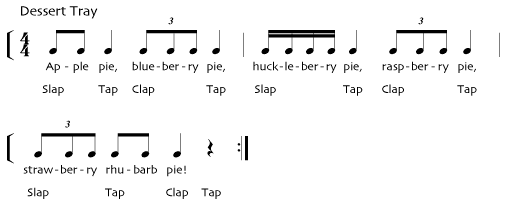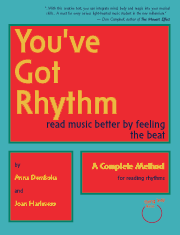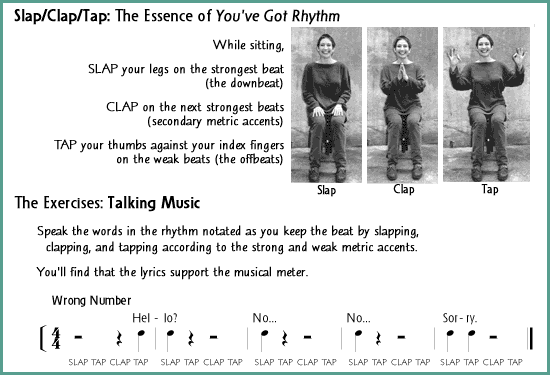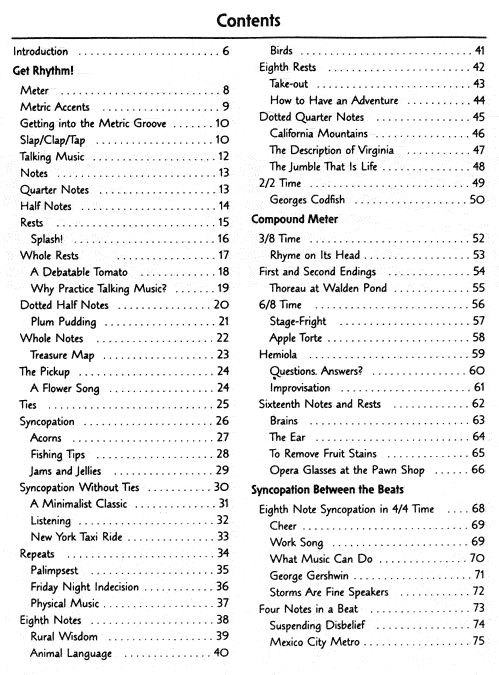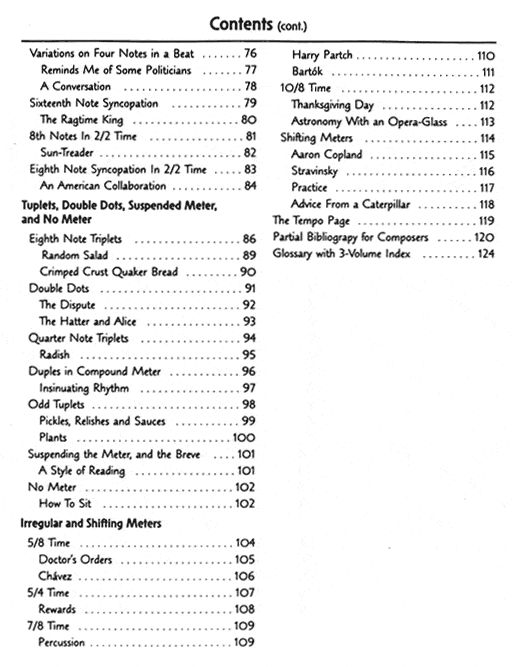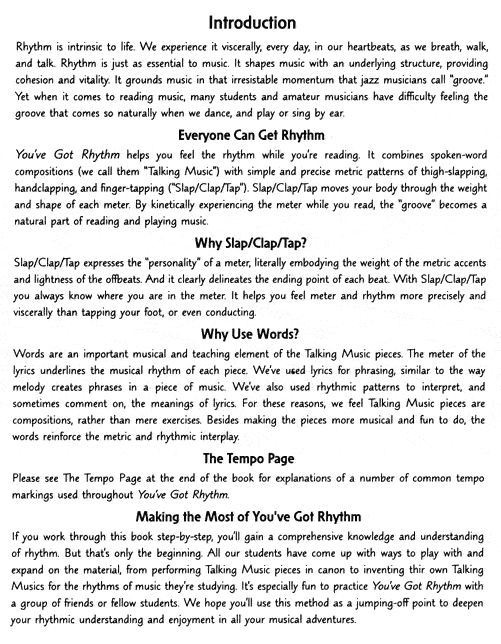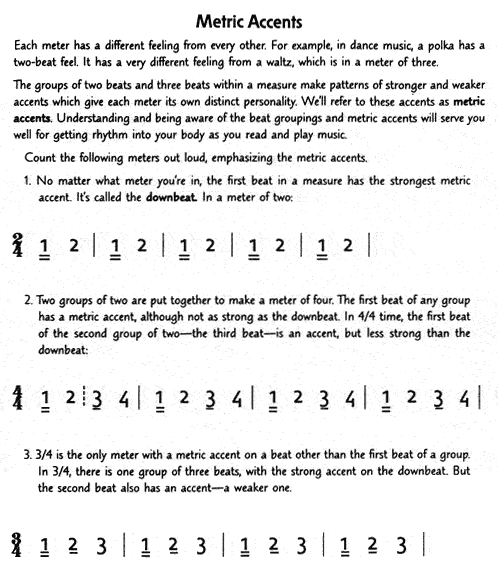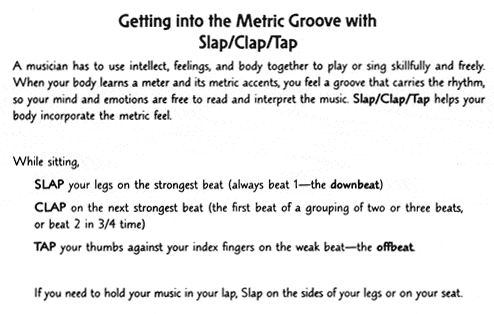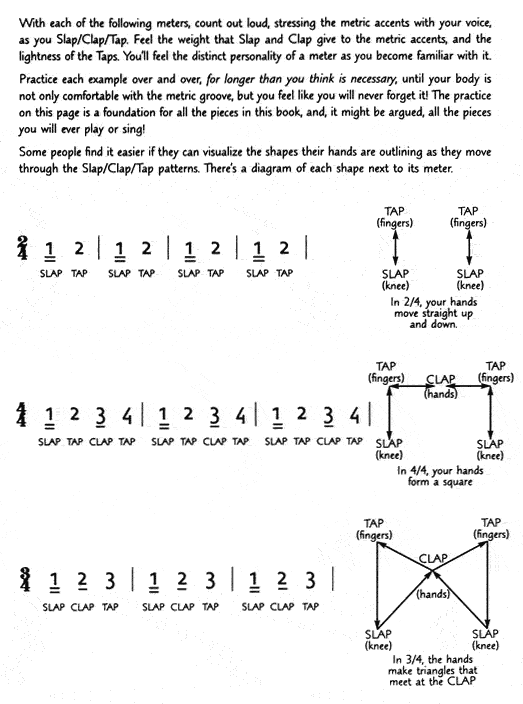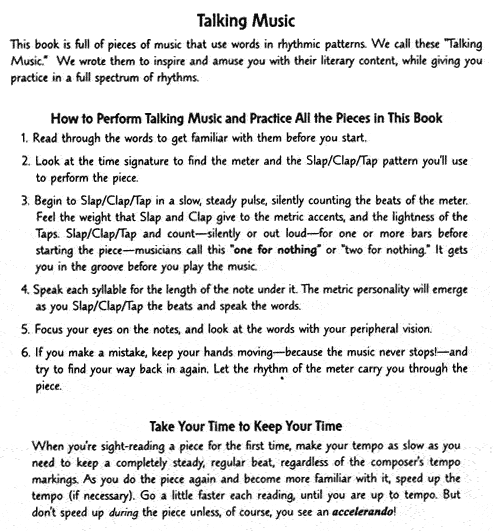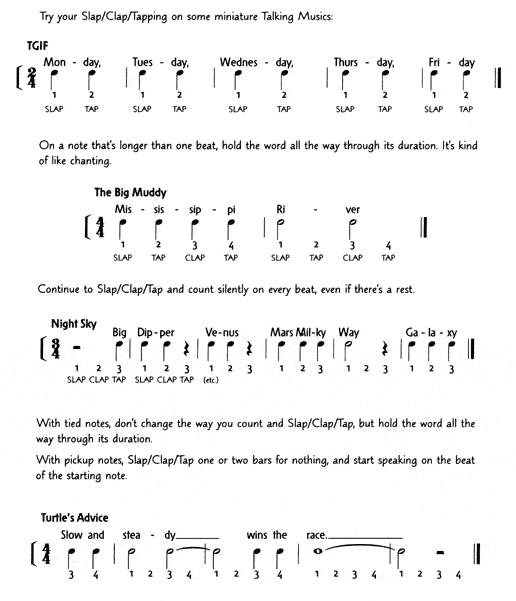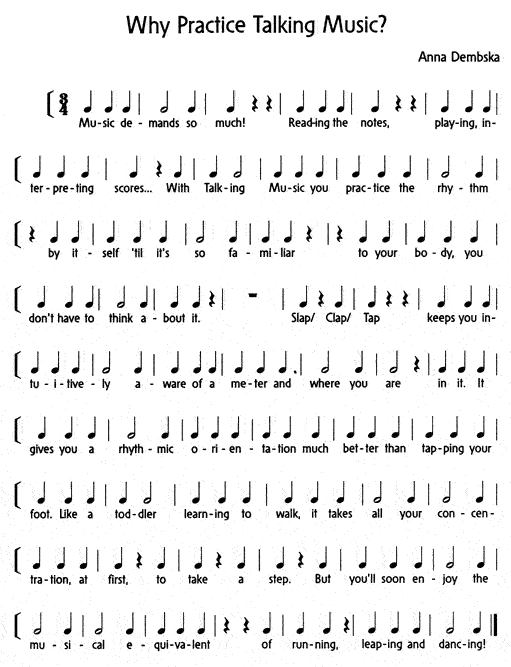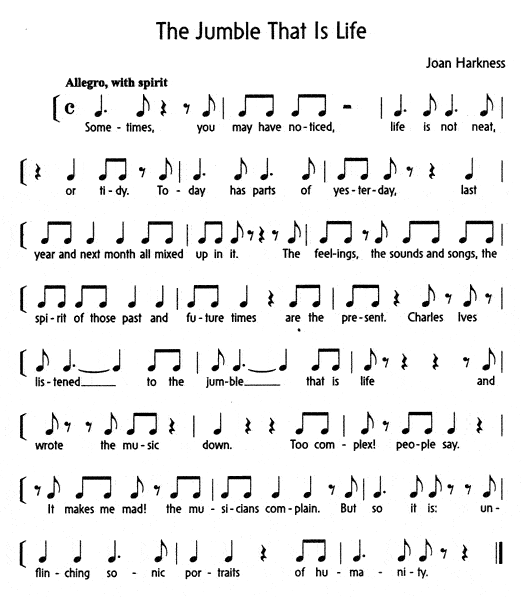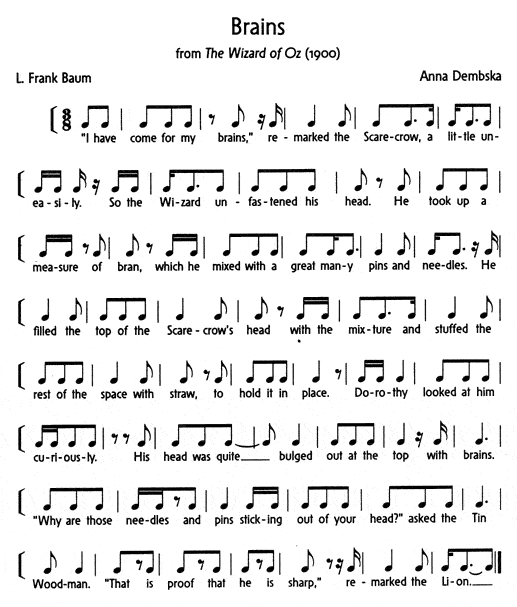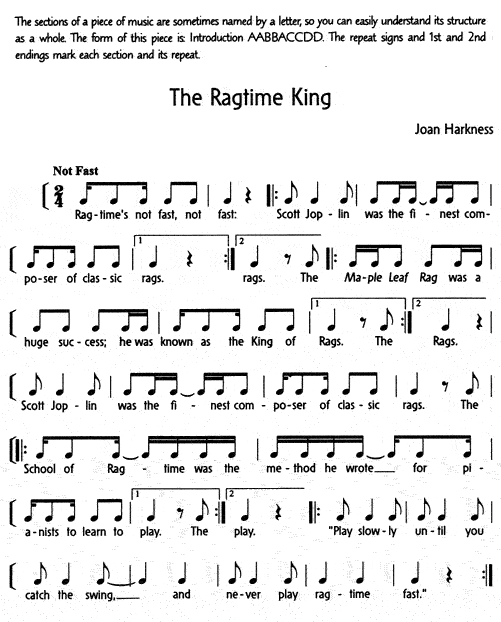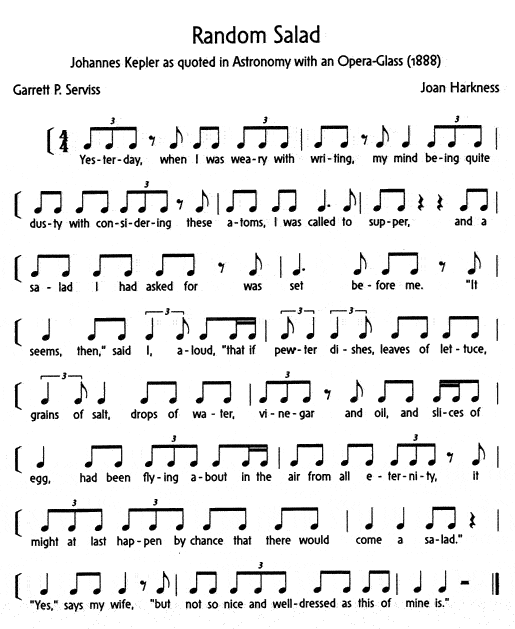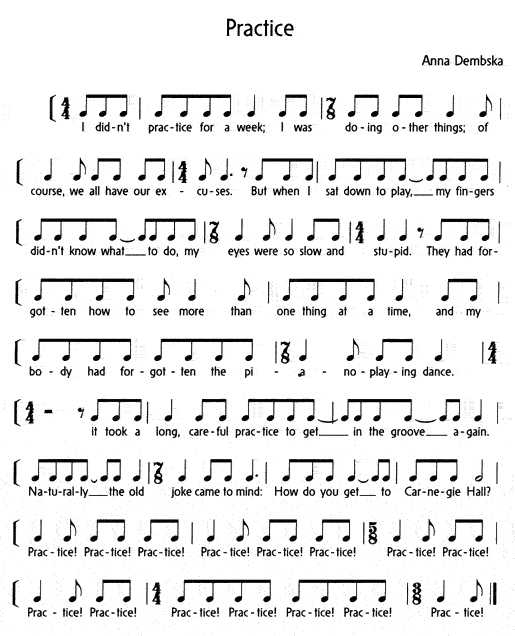Tips for using You've Got Rhythm
3/7/06: Rhythmic Obsession
One of the best things you can do to improve your rhythmic skill is to become obsessed by it. Every waking moment is time you can use to internalize the feeling of a steady beat, the divisions of a beat, or a particularly tricky rhythm that's holding you up.
Rhythmic focus between practice sessions is amazingly beneficial. It helps you get used to doing two or more things at once, such as slap/clap/tapping while reading your email, or counting "1and2and3and4and" in time with your pace as you walk down the street. Best of all, when you do finally get to your practice session, you really will have a feel for the beat which you can put right to work in the music you play.
How to do it: 1. Slap/Clap/Tap in all meters whenever you can. Be obsessed by your rhythmic mission! 2. Any time you take a stroll or go running, you have perfect opportunity to practice a steady beat. Given our two legs, counting in "1 2 1 2" or "1 2 3 4" while you step is easiest, but 6/8 will work too (stepping on beats 1 and 4). 3. Counting subdivisions of a beat while ambulating is even better. To practice eighth notes, say "1 and 2 and" or "willy nilly." Practice sixteenth notes with "1 ee and uh 2 ee and uh" or "rollercoaster rollercoaster." Don't forget triplets, saying "bicycle tricycle" as you go. 4. You can count while you drive, although it's not as effective as counting while walking. Remember to emphasize the metric accents with your voice. 5. If there's a rhythmic phrase in a piece you are playing that gives you trouble, Slap/Clap/Tap and sing it throughout the day, using your music if necessary. Lots of tiny practice sessions keep your mind and body in the groove of rhythm. When you finally get to practice, you will notice how "fit" you have become!
November, 2003: Attention: devotees of Brahms, Chopin, and Salsa: How to feel 2 against 3 with Slap/Clap/Tap
Getting the feel of playing 2 against 3 can be a hair-pulling experience for students (or maybe it's harder on the teacher). Slap/Clap/Tap makes it easy to hear and feel 2 against 3. It not only works beautifully for students—we've also been getting our concert audiences to try it. They have a great time getting into that hemiola groove. It's fun to do this with other people, but you can try it by yourself too.
- Together, Slap/Clap/Tap in 6/8, clearly marking the eighth note Taps and feeling the metric accents on beats 1 and 4.
- Keeping the same 8th-note pulse, Slap/Clap/Tap in 3/4, counting "1-and 2-and 3-and to clarify the eighth note subdivisions. Start by counting out loud, then try counting silently. Keep going until you feel the 8th-not pulse internally.
- (In a group) Assign the meters to two groups or two people, and Slap/Clap/Tap them simultaneously. Stay with it until everyone hears the way 2 against 3 sounds and can feel it too. When you all have the hang of it, switch meters.
- (Solo) Alternate Slap/Clap/Tapping a measure of 3/4 with a measure of 6/8. If you feel the eighth note pulse securely, it won't be a strain at all.
January, 2003: Sightreading
What is sightreading? Here's a personal definition: sightreading is simultaneously playing unfamiliar music while looking ahead and preparing to play future unfamiliar music. That's pure multi-tasking! To sightread successfully, two rules must be followed: look ahead and keep going. Slap/Clap/Tap is a tool that can help. Here's how:
When you Slap/Clap/Tap, you create the beat and feel it in your body—you get into the groove. The trick is to allow your body to learn the Slap/Clap/Tap pattern so well that your mind doesn't have to think about it. Before you begin any Talking Music piece, or any piece of music in which you are focusing on rhythm, Slap/Clap/Tap for a long time, longer than you might expect. Test yourself: can you have a conversation (just chit-chat will do) with someone while Slap/Clap/Tapping? If so, you've got it! You've got it in your body, out of your mind's way, so you can keep going no matter what.
But how does Slap/Clap/Tap help you look ahead? By putting the beat in your body with Slap/Clap/Tap, you always know where you are in the music. That takes care of one really basic element—the meter—so your mind is freed up to take on that extra task of looking ahead. Then, instead of running behind the music, trying to catch up, you can stay one step ahead of it!
Tip #1a: Dance!
We've noticed that some people have a tendency to Slap/Clap/Tap with stiff, military precision, trying so hard to "do it right" that they have trouble feeling the groove. Think of Slap/Clap/Tap as a dance. Feel the flexibility in your torso while your arms move through the metric patterns, as if you're dancing or moving to music. Noticing the weight of the Slaps and the lightness of the Taps will help your arms dance too.
Tip #1b: Slap/Clap/Tap to Your Favorite Music
You can also practice the Slap/Clap/Tap while listening to your favorite music. Listen for the meter and downbeats, then Slap/Clap/Tap along with the music. Keep trying different patterns if the one you're doing doesn't quite fit. This exercise will develop your sense of the distinct groove of each meter.
You might have the most fun with You've Got Rhythm by getting together with other people to practice. Try it out at your next piano class, choir rehearsal, or coffee klatch and see!
Tip #2: Feeling and Hearing the Subdivisions of a Beat
The first step in becoming fluent in counting the beats and subdivisions of a piece is to speak and hear the subdivisions while Slap/Clap/Tapping the meter. Use numbers or the words used in You've Got Rhythm: 1-and 2-and or "willy nilly" for eighth notes; 1-ee-and-a 2-ee-and-a or "rollercoaster" for sixteenth notes; 1-and-a 2-and-a or "bicycles tricycles" for triplets. Or make up your own words for the subdivisions. Here are some time-honored pies to practice quarter notes, eighth notes, triplets, and sixteenths:
